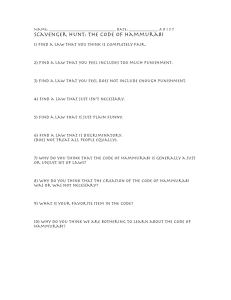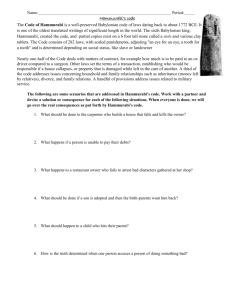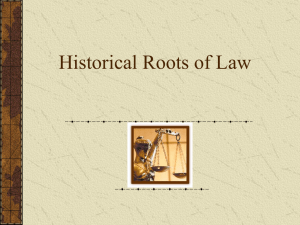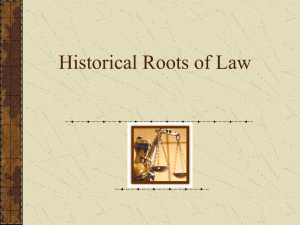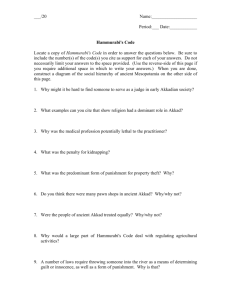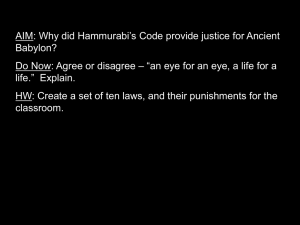2nd and 4th hour History - Week of September 30, 2012
advertisement
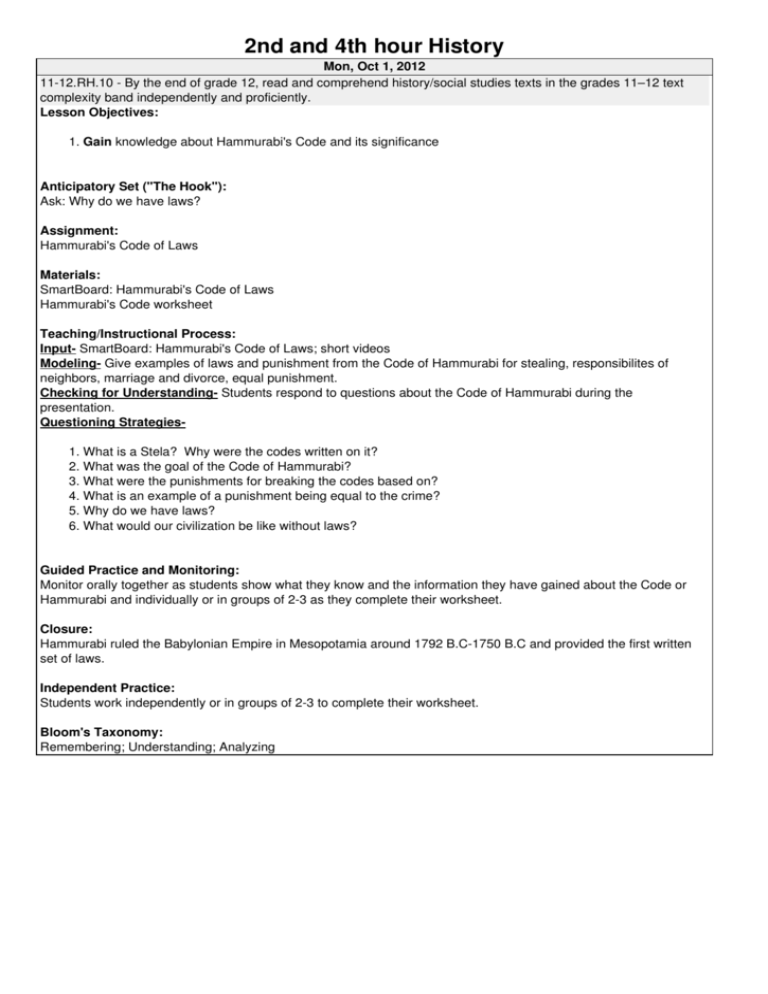
2nd and 4th hour History Mon, Oct 1, 2012 11-12.RH.10 - By the end of grade 12, read and comprehend history/social studies texts in the grades 11–12 text complexity band independently and proficiently. Lesson Objectives: 1. Gain knowledge about Hammurabi's Code and its significance Anticipatory Set ("The Hook"): Ask: Why do we have laws? Assignment: Hammurabi's Code of Laws Materials: SmartBoard: Hammurabi's Code of Laws Hammurabi's Code worksheet Teaching/Instructional Process: Input- SmartBoard: Hammurabi's Code of Laws; short videos Modeling- Give examples of laws and punishment from the Code of Hammurabi for stealing, responsibilites of neighbors, marriage and divorce, equal punishment. Checking for Understanding- Students respond to questions about the Code of Hammurabi during the presentation. Questioning Strategies1. What is a Stela? Why were the codes written on it? 2. What was the goal of the Code of Hammurabi? 3. What were the punishments for breaking the codes based on? 4. What is an example of a punishment being equal to the crime? 5. Why do we have laws? 6. What would our civilization be like without laws? Guided Practice and Monitoring: Monitor orally together as students show what they know and the information they have gained about the Code or Hammurabi and individually or in groups of 2-3 as they complete their worksheet. Closure: Hammurabi ruled the Babylonian Empire in Mesopotamia around 1792 B.C-1750 B.C and provided the first written set of laws. Independent Practice: Students work independently or in groups of 2-3 to complete their worksheet. Bloom's Taxonomy: Remembering; Understanding; Analyzing 2nd and 4th hour History Tue, Oct 2, 2012 11-12.RH.10 - By the end of grade 12, read and comprehend history/social studies texts in the grades 11–12 text complexity band independently and proficiently. Lesson Objectives: 1. Gain knowledge about Hammurabi's Code and its significance Anticipatory Set ("The Hook"): Ask: Why do we have laws? Assignment: Hammurabi's Code of Laws Materials: SmartBoard: Hammurabi's Code of Laws Hammurabi's Code worksheet Teaching/Instructional Process: Input- SmartBoard: Hammurabi's Code of Laws; short videos Modeling- Give examples of laws and punishment from the Code of Hammurabi for stealing, responsibilites of neighbors, marriage and divorce, equal punishment. Checking for Understanding- Students respond to questions about the Code of Hammurabi during the presentation. Questioning Strategies1. What is a Stela? Why were the codes written on it? 2. What was the goal of the Code of Hammurabi? 3. What were the punishments for breaking the codes based on? 4. What is an example of a punishment being equal to the crime? 5. Why do we have laws? 6. What would our civilization be like without laws? Guided Practice and Monitoring: Monitor orally together as students show what they know and the information they have gained about the Code or Hammurabi and individually or in groups of 2-3 as they complete their worksheet. Closure: Hammurabi ruled the Babylonian Empire in Mesopotamia around 1792 B.C-1750 B.C and provided the first written set of laws. Independent Practice: Students work independently or in groups of 2-3 to complete their worksheet. Bloom's Taxonomy: Remembering; Understanding; Analyzing 2nd and 4th hour History Wed, Oct 3, 2012 11-12.RH.2 - Determine the central ideas or information of a primary or secondary source; provide an accurate summary that makes clear the relationships among the key details and ideas. 11-12.RST.4 - Determine the meaning of symbols, key terms, and other domain-specific words and phrases as they are used in a specific scientific or technical context relevant to grades 11–12 texts and topics. Lesson Objective: 1. Create a poster that calls people to a meeting about Hammurabi's Code. Anticipatory Set ("The Hook"): You are a government leader whose job is to explain Hammurabi's Code to people. How do you get people together so you can explain the new system to them? Assignment: Hammurabi's Code Materials: Hammurabi's Code worksheet Plain paper Markers or colored pencils Anticipatory Set ("The Hook"): Input- Discuss the importance of getting the word out to all the people of Mesopotamia about the new laws. Modeling- Show examples of documents that are used to gain the attention of people so they can receive specific information. Checking for Understanding- Student responses during discussion and applying concepts learned in creating an informational poster. Questioning Strategies1. There was no TV or Internet in ancient Mesopotamia so what would be the best method to let people know that you are going to hold a meeting? 2. Is it important to let as many people possible know about the new laws, or would it be okay to just enact them? Explain. 3. What if people are too busy to attend the meeting what could you use to get their attention and attend? 4. Why should your poster be clear about what the meeting will be about? Guided Practice and Monitoring: Monitor orally together during presentation and individually as student work independently to create their informational poster. Closure: Imagine that you are a government leader whose job is to explain Hammurabi's Code to the people. Make a poster inviting people to come to a meeting where they will learn about the new laws. Your poster should advertise the meeting and explain the laws. Prepare to share your poster with the class. Independent Practice: Students work independently to create an informational poster that calls together the people to a meeting where they will learn about the Code of Hammurabi. Bloom's Taxonomy: Remembering; Understanding; Applying; Analyzing 2nd and 4th hour History Thu, Oct 4, 2012 11-12.RH.2 - Determine the central ideas or information of a primary or secondary source; provide an accurate summary that makes clear the relationships among the key details and ideas. 11-12.RST.4 - Determine the meaning of symbols, key terms, and other domain-specific words and phrases as they are used in a specific scientific or technical context relevant to grades 11–12 texts and topics. Lesson Objective: 1. Create a poster that calls people to a meeting about Hammurabi's Code. Anticipatory Set ("The Hook"): Imagine that you are a government leader whose job is to explain Hammurabi's Code to the people. Make a poster inviting people to come to a meeting where they will learn about the new laws. Your poster should advertise the meeting and explain the laws. Prepare to share your poster with the class. Assignment: Hammurabi's Code Materials: Hammurabi's Code worksheet Plain paper Markers or colored pencils Anticipatory Set ("The Hook"): Input- Discuss the importance of getting the word out to all the people of Mesopotamia about the new laws. Modeling- Show examples of documents that are used to gain the attention of people so they can receive specific information. Checking for Understanding- Student responses during discussion and applying concepts learned in creating an informational poster. Questioning Strategies1. There was no TV or Internet in ancient Mesopotamia so what would be the best method to let people know that you are going to hold a meeting? 2. Is it important to let as many people possible know about the new laws, or would it be okay to just enact them? Explain. 3. What if people are too busy to attend the meeting what could you use to get their attention and attend? 4. Why should your poster be clear about what the meeting will be about? Guided Practice and Monitoring: Monitor orally together during student presentations of their informational posters. Closure: What were the most important features of the Code of Hammurabi? Do you think that the laws were fair to everyone? Explain. Independent Practice: Students work independently to finish their informational poster that calls together the people to a meeting where they will learn about the Code of Hammurabi and then share their posters with the class. Bloom's Taxonomy: Remembering; Understanding; Applying; Analyzing 2nd and 4th hour History Fri, Oct 5, 2012 11-12.RST.4 - Determine the meaning of symbols, key terms, and other domain-specific words and phrases as they are used in a specific scientific or technical context relevant to grades 11–12 texts and topics. Lesson Objective: 1. Examine the Assyrian and Babylonian civilizations. 2. Identify early rulers of the Babylonian empires: Hammurabi, Nebuchdnezzar II, Cyrus the Great, and Alexander the Great. Anticipatory Set ("The Hook"): In your opinion what makes a good leader? What characteristics would you look for in a leader? Do you know anyone that fits your ideal expectations of a leader? Assignment: Babylonia and Assyria Materials: PPT: Babylonia and Assyria Later Civilizations of Mesopotamia worksheet Teaching/Instructional Process: Input- PPT: Babylonia and Assyria; short video Modeling- Model how to take notes to fill in a time line of facts on the civilizations of Mesopotamia: Assyrian Empire, King Nebuchdnezzar II, Empire of Alexander the Great, Chaldean Empire, Persian Empire. Checking for Understanding- Monitor students as they complete their timeline during the presentation. Questioning Strategies1. Who were the two ruling empires after the defeat of Sumeria? 2. Who was Hammurabi? 3. What is a caravan? 4. What is a bazaar? 5. What is the Code of Hammurabi? Why was it important? 6. What is the stone called that contains the Codes? 7. How did war and conquest help Babylon to get rich? 8. Who were the Assyrians? 9. What were some inventions of war attributed to the Assyrians? 10. What two empires defeated Assyria? How did they accomplish it? 11. Who was Nebuchdnezzar II? Guided Practice and Monitoring: Monitor students orally together during the presentation asking guiding questions and directing them to put important details in their timeline. Closure: If civilizations grew because of war how is war beneficial to a society? Independent Practice: Students work independently to complete their timeline and use the information from the Powerpoint to assist. Bloom's Taxonomy: Remembering; Understanding; Applying; Analyzing Powered by TCPDF (www.tcpdf.org)
